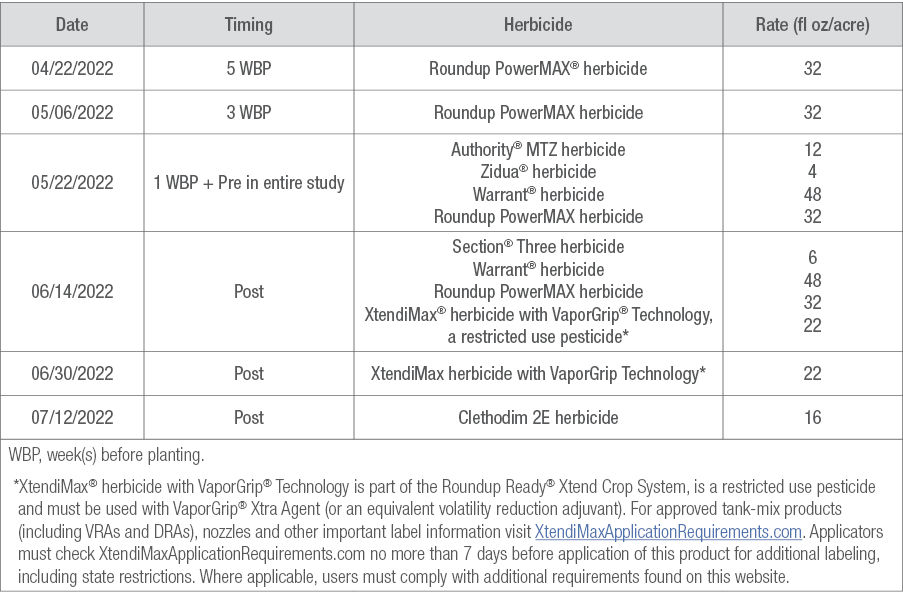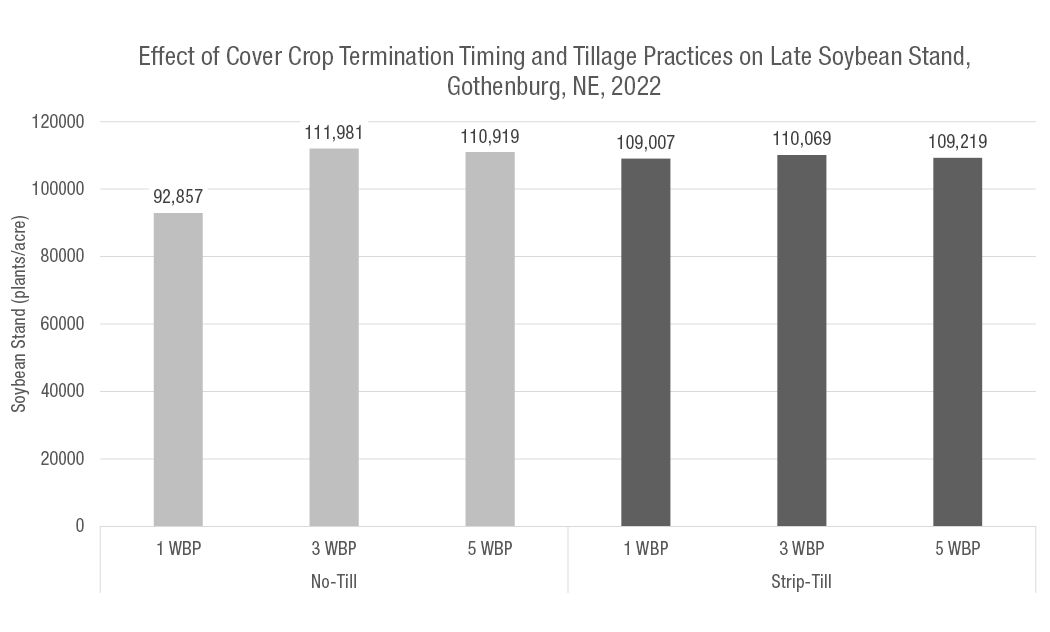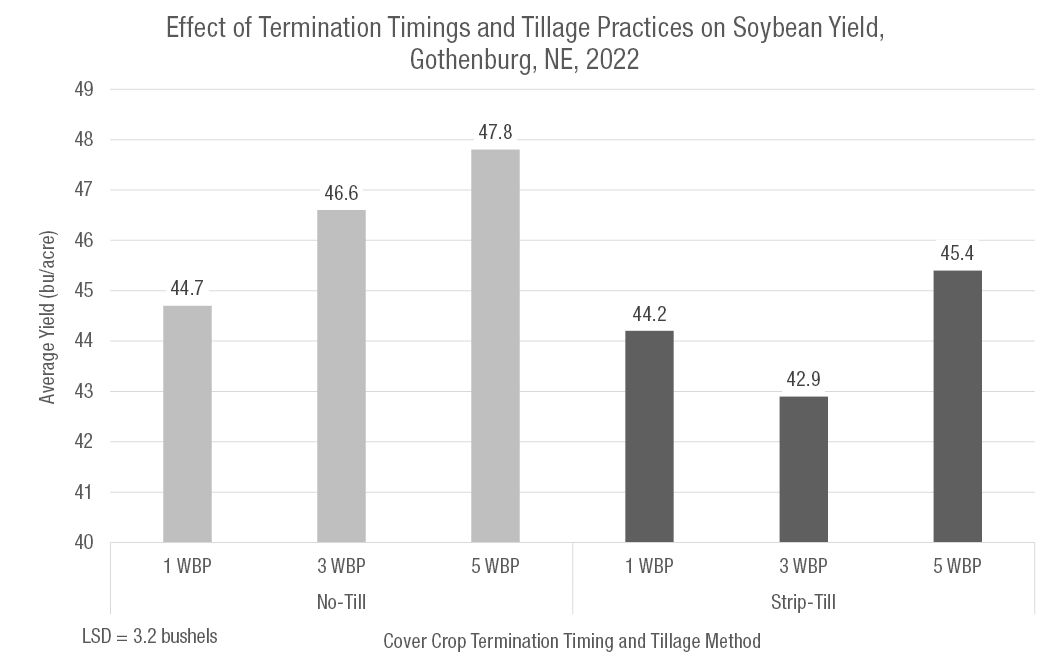Effect of Tillage Practice on Cover Crop Termination Timing on Soybean Production
March 8, 2023
TRIAL OBJECTIVE
- Determining when to terminate a cover crop while getting the most benefit out of the cover crop and maintaining the yield potential can be impacted by the tillage practice.
- The objective of this trial was to determine the interaction between cover crop termination timing and tillage practice, as well as the effect on soybean stand, weed suppression, and yield.
RESEARCH SITE DETAILS
| Location | Gothenburg, NE |
| Soil Type | Hord silt loam |
| Previous Crop |
Corn |
| Tillage Type |
Strip-tillage and no-till |
| Planting Date | 06/01/22 |
| Harvest Date | 10/18/2022 |
| Potential Yield (bu/acre) |
90 |
| Seeding Rate (seeds/acre) |
160,000 |
- This trial was designed as a split-plot with cover crop termination timing as the whole plot and tillage practice (strip-till or no till) as the sub-plot.
- The cover crop species used was winter wheat which was drilled at 120 lbs of seed/acre on 11/11/2021.
- On 4/12/2022 the trial had a base fertilizer application of 29 lbs of nitrogen (N)/acre, 60 lbs of phosphorus (P)/acre, 25 lbs of sulfur (S)/acre, and 0.25 lb of zinc (Zn)/acre. The fertilizer was applied with a strip-till machine in the strip-tilled plots and banded on the soil surface of the no-till plots.
- All treatments were planted in 30-inch row.
- Each termination timing of 1, 3, and 5 weeks before planting (WBP), was paired with no-till and strip-till (Table 1).
- Cover crops were terminated using Roundup PowerMax® herbicide at 32 fl oz/acre with a spray volume of 15 gal/acre (Table 2).
Table 1. Treatments with cover crop termination timings and tillage practice treatment combinations.

Table 2. Herbicide applications made during the 2022 growing season.

- Pre-plant, burndown, and post-emergence herbicide applications are listed in Table 2. All plots had identical weed management but differed in cover crop termination timing.
- A total of 6.48 inches of precipitation accumulated during the soybean growing season. An additional 8 inches of water was applied by sprinkler irrigation which was a limited amount, leading to lower-than-normal yields.
- Weed suppression and early soybean stand were assessed when the crop reached the V1-V2 growth stage, prior to the first post-emergence herbicide application. Late stand assessment notes were recorded close to soybean harvest time.
- Primary weed species evaluated in this trial were Palmer amaranth (Amaranthus palmeri) and volunteer corn.
- The trial was harvested with a plot combine, measuring grain moisture content, test weight, and total grain weight to determine yield.
UNDERSTANDING THE RESULTS
- Winter wheat biomass accumulation took off after April 25th due to dry weather in the fall of 2021 and spring of 2022. By the time 1 WBP was terminated, the cover crop canopy cover was 45.5% of the soil, compared to 1.2% and 0.5% in the 3 WBP and 5 WBP, respectively. Therefore, there was no significant cover crop growth in the 3 WBP and 5 WBP treatments (Figure 1).

- Weed pressure in this trial was high and required four herbicide applications to achieve effective weed control. Weed suppression was greater (66%) when the cover crop was terminated 1 week before soybean planting (1 WBP) compared to 3 WBP and 5 WBP (Figure 2). The increased cover crop biomass accumulation in treatment 1 WBP helped building canopy closure to compete against weeds in the area. No difference in weed suppression was found between tillage practices.

- There was an advantage of strip-till compared to no-till for early stand of soybean which could be due to the increased seed bed quality that is provided by strip-tilling (Figure 3).

- No-till and strip-till reached similar soybean late stands, with the exception of the cover crop termination timing 1 week before soybean planting (1 WBP) in the no-till system (Figure 4). That is likely due to the increased cover crop biomass that impacted soybean emergence (Figure 1).

- In general, soybean yield was better with no-till than strip-till. On average, soybean yields in no-till were 46.4 bu/a compared to 44.2 bu/a in the strip-till treatment (Figure 5).
- There were no significant soybean yield responses due to cover crop termination timing (Figure 5).
- Although the soybean stand in the strip-till treatment was better than the no-till, the no-till plots had higher yields. This emphasizes the ability of soybean to adapt to population reductions.

KEY LEARNINGS
- Winter wheat cover crop helped to increase weed suppression (mostly Palmer amaranth) when terminated 1 week before planting (WBP) soybean. Cover crop canopy is key to providing soil coverage and could be used as a weed management tool.
- The strip-till treatments had higher early emergence and final stand than no-till, but soybean plants have the ability to adapt to adverse growing conditions and can produce similar yields with a reduced stand when the growing conditions are favorable.
- In a dry year like 2022, soil moisture preservation is key to achieving better yields. In this scenario, no-till treatments yielded better likely due to more soil moisture present. The strip-till plots possibly lost moisture by having the soil exposed to the environment due to the strip-till machine removing residue cover from the row. In addition, cover crops can use moisture and must be terminated timely. In this study we saw a trend of lower yields (not significant) when cover crops were terminated at 1 WBP.
- The soybean yields were similar across the cover crop termination timings likely due to irrigation application.
1310_186504